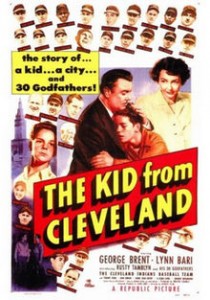Category — Cleveland, Full
THE HEYMISH AND THE AMISH
I live near two large Amish settlements — Middlefield, Ohio, and Holmes County, Ohio. I know some of the differences between the various Amish, like some use battery-powered lights on their buggies and some don’t. Some use the triangular orange “slow vehicle” sign.
Speaking of men-in-black, I also know some Orthodox Jews. I know the crocheted yarmulke means Modern Orthodox and the black hat is more old school. I’ve been around Amish and Jews — at the same time — only once. I walked into Green Road Synagogue (an Orthodox shul) in Cleveland, and there was an Amish man in the lobby. Maybe not. Maybe he was a Modern Orthodox hipster trying to look Amish. He had a wide-brim straw hat, beard, no mustache a la Solzhenitsyn.
Then I saw about 15 Amish women, carrying parfaits on trays, wearing blue dresses and white bonnets, coming out of the kitchen. Next I saw a horse and buggy at the side door of the synagogue. Orthodox Jews started arriving. Most were Modern Orthodox (like dentists and lawyers in knit yarmulkes), but a couple old-school rabbis looked Amish.
“Solzhenitsyn” stacked bales of hay in the temple lobby and brought in chickens. He was John, an Amish from Middlefield. He said he used to be a wheelwright and now worked for an Orthodox Jew in a mattress factory. The mattress-factory owner was hosting this sheva brochas (post-wedding dinner). My band, Yiddishe Cup, was playing. The Orthodox host — the mattress man – was a musician, himself, who had some show-biz flair. He was doing a Blazing Saddles party theme. I asked the Amish buggy driver what he thought of our music. He said, “It sounds like Mozart.” Maybe because of the violin?
“Solzhenitsyn” said some Amish in Ohio play harmonica. “That’s all, for instruments,” he said. “Other instruments [like flute, guitar] might lead to forming a band.” A Jewish joke?
The rabbi, as a joke, asked if we knew any Amish songs. We played “Amazing Grace.” That’s borderline Amish. It was probably a first for Green Road Synagogue. The Amish liked the song, and the Jews ignored us. Then we tried a Yiddish vocal, “Di Grine Kusine,” which didn’t go over. I thought the Amish would like it because Pennsylvania Dutch is Germanic, just like Yiddish. The Amish didn’t react to the song. Now I know: no “Di Grine Kusine” at Amish-Jewish affairs.
—
I had a funny article in the Wall Street Journal last week about old guys playing tennis. Here’s the link. No paywall. And check out the comments, particularly if you’re an old guy.
July 14, 2021 5 Comments
SHOUSE. HE RAISED MONEY
Ben Shouse was a volunteer fundraiser for the Workmen’s Circle. He had a booming voice and a shock of gray hair like H.L. Mencken, and he wore suits like Mencken, and he smoked a cigar like Mencken. Politically speaking, Shouse was un-Menckenable. He was a retired labor union boss and an autodidact (he liked words like inculcate), and he was an advocate for the arts, especially Shakespeare-for-workers stuff.
Shouse phoned me, suggesting Yiddishe Cup pony up for the Workmen’s Circle annual banquet. Yiddishe Cup would be the honoree. He said, “Stratton, you know how these things work.”
I didn’t know how these things worked. Not in 1994. I thought Yiddishe Cup would be honored because we were good. Sort of an arts prize.
Two Yiddishe Cup musicians told me they couldn’t afford the price of the dinner, let alone bring friends. Crazier still, Shouse said, “Buy a table.” I corralled three people, including my wife, into coming. I didn’t want to hock friends for a chicken dinner at a cheesy Alpha Drive party center. Also, my friends wouldn’t want to listen to speeches about Workmen’s Circle, an organization most of my friends had never heard of.
Shouse phoned Yiddishe Cup’s singer and said: “Stratton gave $55. Greenman gave $25. How about you, and who are you bringing?” The singer was speechless.
One Yiddishe Cup musician didn’t even show up for the tribute.
Another Yiddishe Cup musician replayed a phone message from Shouse: “This dinner is in your fucking honor! You’re sophisticated. You know the rules. Do your part!”
Shouse raised a lot of money for the arts.
—
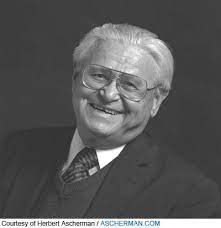
Ben Shouse (Photo by Herb Ascherman) [Shouse died in 2003.]
FREE CONCERT THIS SUNDAY.
Funk A Deli, a k a Yiddishe Cup, is playing on a front lawn near you this Sunday (June 13, 5-7 pm.).
23500 Laureldale Road, Shaker Heights, Ohio. Near Laurel School.
Bring a lawn chair or blanket. Bring dinner. Plop yourself and your possessions on the grassy median strip on Laureldale Road.
The band will play a mix of klezmer and soul music.
June 9, 2021 4 Comments
THE RECORD COLLECTOR
Jack Saul was a major-league record collector. You couldn’t find a seat in his house unless he moved a ton of records. Every time he played a record he’d clean it with Windex. No scratches. Smooth-h-h.
He didn’t throw anything out — since day one. He even had a John McGraw baseball card. (McGraw played 1891-1906.) When I sold my baseball cards in 2007, Jack said, “Why’d you do that?” (I wasn’t looking at ’em, Jack, and my kids didn’t want ’em. They didn’t know who Harmon Killebrew was.) “Why’d you do that?” he repeated.
The Cleveland Jewish music scene was all about Jack Saul. Musicians from the Kleveland Klezmorim went to Jack’s house in the early 1980s to record 78s. Those 78s were pristine. When Boston public radio (WGBH) did a show in 2000 about Mickey Katz, they came to Jack for clean recordings. Jack never let a record out of his house. You had to sit there for an hour, or two, and have him dub the records onto tape.
He always had time for musicians. The first time I went to his house, in 1988, I recorded cuts from Music For Happy Occasions, Paul Pincus; Jay Chernow and his Hi-Hat Ensemble; Dukes of Frelaichland, Max Epstein; Jewish Wedding Dances, Sam Musiker; Twisting the Frelaichs; and Casamiento Judio, Sam Lieberman. That last one was an Argentinian klezmer record! Jack had almost every Jewish record. And he had it in both monaural and stereo.
Jack’s favorite popular musicians were Guy Lombardo and pianist Irving Fields. Jack liked musicians who, when they improvised, stayed close to the melody. He phoned Fields when I was over. “What’s new, Irving? I’d like to get you to Cleveland.” Never happened. Everybody talked to Jack, because for one thing, he could supply them with recordings of their own works that they, the musicians, couldn’t even remember making.
Jack had a thing for Guy Lombardo. Jack’s thesis was Guy Lombardo was behind “Bay mir bistu sheyn”s popularity. Jack gave me an article from The New Yorker, Feb. 19, 1938, titled “Everybody’s Singing It — Bie Mir Bist Du Schoen. Played on the air for the first time by Guy Lombardo, Radio Made it the Nation’s No. 1 Hit.”
Jack liked my band, Yiddishe Cup. (He also liked Steven Greenman, Lori Cahan-Simon and Kathy Sebo — Cleveland Jewish musicians.) At a meeting of the Workmen’s Circle Yiddish concert committee, Jack said, “We’ve got talent in this town. We don’t always have to run to New York [for entertainers].” That meant a lot to us locals.
When Jack talked, the rest of the committee listened. He had a stellar rep — Cleveland Orchestra and Sir Thomas Beecham Society credibility. Jack had every Beecham recording. That classical-music imprimatur really cut it with the older klezmer crowd.
Flip side: the rough-edged 78 recording of Abe Elenkrig’s Orchestra playing “Di Zilberne Chasene” (“The Silver Wedding”). Jack had thousands of records like that. Gritty. But not a scratch.
Jack Saul made Jewish music in Cleveland.
Jack died in 2009 at age 86, and his records went to Florida Atlantic University.
—
P.S. A lot of this post was first published in the Cleveland Jewish News in May 2009, but it never got online at the CJN. So by local, contemporary standards, the story doesn’t exist. Does now!
P.P.S. Here’s a comment by Hankus Netsky, leader of the Klezmer Conservatory Band, posted on the Klezmershack website in May 2009:
“What a great guy Jack was. By the way, I’m the one who sent WGBH to Jack’s house for the Mickey Katz records. Before our tour with Joel Grey’s Katz review, ‘Borscht Capades,’ in 1994, I had visited Jack, who had made me the ultimate Katz compilation. We couldn’t have done the show without those recordings — Joel himself had never heard a lot of them!
“Besides the records in every corner (but not in the kitchen, the one concession to his loving and remarkably tolerant wife), the other amazing thing were the front walls of the house that had been hollowed out and replaced with speakers of every shape, size, and frequency.
“A great loss. I sure hope they have a good hi-fi up there . . .”
May 26, 2021 4 Comments
THE ESTHER ISENSTADT ORCHESTRAS
Esther Isenstadt, a bassist, ran classified ads in the Cleveland Jewish News in the 1970s-80s: “Sophisticated music for discriminating people” . . . “Leave your records at home and bring LIFE to your party” . . . “From ‘The Hora’ to ‘Beat It.'”
I didn’t see her much around town. She worked the senior-adult circuit while Yiddishe Cup played the glam jobs: bar mitzvahs and weddings. Seriously, that’s where the money was. Esther played classical and pop, and some Jewish.
Many years later (2003), I ran into Esther at The Weils, an assisted living facility. She was 86. I told her I had one of her recycled Tara Publications Israeli songbooks. I had bought it used at the Cleveland Music School Settlement. She smiled. Then she didn’t smile, and said, “I never thought I’d end up here!”
Esther had played in four suburban orchestras, raised a family, taught elementary school, led party bands and taught ESL in “retirement.” I had learned “Shir Lashalom” (“A Song of Peace”) from Esther’s book. That tune was a must-play in 1995 — the year Yitzhak Rabin was assassinated.
Esther had rubber-stamped Esther Isenstadt Orchestras in her songbooks. A Jewish bandleader with a rubber stamp. I got a rubber stamp.
Maybe I’ll follow her into The Weils. But I doubt it. I’m more a Menorah Park guy. Closer to town. (Esther died in 2010.)
April 14, 2021 4 Comments
TAXI DRIVER
The taxicab supervisor, smoking a stogie, asked me, “Where’s Charity Hospital?”
“I don’t know,” I said.
“Where’s the Federal Building?”
“Ninth Street.”
“The Pick-Carter Hotel?”
“I don’t know.”
“The Hollenden House?”
“Downtown — St. Clair.”
“People want to know where their hotel is,” he said. He hired me. He worked for Universal Cab, a division of Yellow Cab. I drove welfare recipients with vouchers to hospitals, and workers to Republic Steel Works #4. I didn’t drive rich people; I thought I was going to drive rich people but it was mostly poor people. I picked up one rich guy, downtown. He said, “Severance Hall.”
I asked, “Are you Claudio Abbado?”
“How do you know!” he said. I told him I’d seen his photo in the Plain Dealer that morning. Afterward, I told a friend John I had driven “a conductor from Italy.”
“So why did he come here?” my friend said. John’s favorite expression was “Cleveland is the armpit of the nation.” (This was in 1970.)
My taxi-driving job went downhill after Abbado. A cabbie told me to carry a bat. He said, “A bat isn’t a concealed weapon. It’s legal.” One time I thought I was being followed by robbers. I got boxed in around St. Luke’s Hospital and escaped by going in reverse. Maybe I was imagining it. I was skittish. To understand, you have to have been around in 1970.
My cab stalled at Fairmount Circle. The engine smoked. I left the cab and hitchhiked back to the Noble Road garage. The supervisor said, “You mean you left your cab, son?”
“I knew I could get back here.”
“You mean you left your cab unattended?”
“Yes.”
Dead end.

February 26, 2020 4 Comments
I’VE BEEN DRINKING
My dad admired bankers. In my dad’s pantheon of great Cleveland families, the number one clan was the Bilskys, who started out making bagels, then went into medicine (#1 son), bowling alleys (#2 son, Mayflower Lanes, Cedar Center), and ultimately started a bank (#3 son, Metropolitan Savings). My grandmother used to say “The Bilskys make big bagels out of little bagels.”
Scott Bilsky — who is a young man — called my klezmer band to book us for a temple event. He said 12 Bilskys would be at the event. Dr. Harold Bilsky (#1 son)? Nope. He died in 2007. Harold had grown up with my dad on Kinsman. Leo (#2 son) wouldn’t be there either. He had died in 1998. I asked Scott. “What about the banker [#3 son]?”
“That’s my grandfather Marvin, He’ll be there.” Marvin was 90. (This was in 2011.) At the temple gig, I cornered Marvin during the band’s break to schmooze. He told me, “Everything I ever did began with a B — baker, banker and builder.” I already knew that. “And brewer,” he said. That, I didn’t know.
Bilsky, a brewski?
Marvin said, “My father bought Cleveland-Sandusky Brewing in 1955. There were very few Jews involved in the brewing business. In the 1960s, Israel came to us for brewing tips and equipment.” Bilsky bottled Gold Bond beer and Olde Timers Ale. Marvin said there had only been five Cleveland breweries in the 1950s: Bilsky, Carlings from Canada (“very nice people”); Standard Brewing, Erin Brew (Irish); Leisy’s (German); and Pilsener’s P.O.C. (Czech). “We all used to meet on Mondays. I didn’t have any trouble with anybody,” Marvin said.
I didn’t know about breweries and still don’t. My father rarely drank; it would have interfered with his worrying. (A Jewish joke.) I knew something about Carlings from Cleveland Indians’ broadcasts; that was about it. I drink a Miller Lite once in a while now. I’m mostly a seltzer guy. Bilsky’s brewery was a blip in the Bilsky family history. Move on to the main subject, coconut bars . . .
The preeminent Bilsky business was Bilsky’s Bakery, which started on Kinsman Road and moved to Cedar Center in 1948. Who invented the Cleveland coconut bar? I should have asked Marvin Bilsky. I didn’t. I called Marvin the next day and said, “Marvin, this is Bert Stratton from Yiddishe Cup, the klezmer band. We played for your family.”
“Thanks for the concert last night. You did as well as you could,” he said. “No, seriously, we enjoyed it. And to answer your question, I’ve always said my father invented the coconut bar, but — and I have to tell you this — I went to Sydney, Australia, and I went down into the subway there. They have a small subway system. They had coconut bars down there. They didn’t call them coconut bars. Where did they get them? Maybe from England. Australia used to be part of England.” [Australians call coconut bars lamingtons.]
“Marvin, I have a friend, Seth, his grandfather was a Kritzer of Kritzer Bakery on Kinsman. Seth says his grandfather invented the coconut bar.”
“It was my father!” Marvin said, groaning. “Who knows.”
I dialed my cousin George, whose father had owned Heights Baking on Coventry. George said his father didn’t invent the coconut bar, but hey, maybe. Scott Raab, a former Clevelander, wrote in Esquire (July 2002): “Ask for coconut bars in any Jewish bakery from New Jersey to Los Angeles and you’ll get some version of this: ‘So, you’re from Cleveland …We don’t have ’em.’”
Nowadays Seth buys his coconut bars at Davis Bakery. I get mine at Zagara’s grocery store. I once asked the Zagara’s clerk where the grocery store got their bars, but the clerk didn’t know. I even looked at the shipping box, which was unmarked.
I invented the coconut bar.
January 15, 2020 2 Comments
WHATEVER HAPPENED TO PUTT PUTT?
My son Teddy had his birthday party at Putt-Putt on Northfield Road in 1990. I think that’s the last time I played Putt-Putt — official Putt-Putt. There are only 23 Putt-Putt courses in the United States.
There was a Chinese miniature golf course on Libby Road at Broadway Avenue. It had a Buddha that went up and down. My high school friends and I couldn’t get enough of that course.
Arnold Palmer Miniature Golf . . . Just had to say that.
I would like to live long enough to play Putt-Putt with my grandchildren. First, I need grandchildren. I want to stay healthy enough to bend down and pick up the ball. That’s the hardest part of miniature golf.
January 1, 2020 3 Comments
THE MICKEY KATZ NON-MOVIE
Eric Krasner wanted to make a movie about Mickey Katz, the Cleveland-born klezmer clarinetist and comedian. Eric came to Cleveland from Atlanta to look around. He wanted to see where Mickey was born, and where Mickey’s wife grew up, and where Mickey’s father’s tailor shop had been. I said, “I’m not a filmmaker — and I don’t want to tell you what to do — but if you want another opinion, I don’t think you should show every place Mickey took a shit.”

1959 album
Eric and I visited the Euclid Avenue Temple (now Liberty Hill Baptist Church), where Mickey was married in 1930. Eric filmed the men’s room and said, “This is where Mickey urinated after his wedding.” Eric asked me why Katz (1909-1985) wasn’t more acclaimed in Cleveland. For one thing, Mickey is not well-known here. He’s not Bob Feller or Superman, or Pekar.
Eric and I went to Glenville, an East Side neighborhood where Mickey spent his teenage years. We found the Glenville Hall of Fame but no Mickey plaque. At Katz’s birthplace, near East 51st and Woodland, Eric drew a sign, “Birthplace of Mickey Katz 1909,” and hung it on a fence and filmed the sign.
Eric announced on Facebook he is giving up on the Mickey Katz film. Mickey’s son Joel Grey has declined to participate in Eric’s film, and that’s a big neg. The movie is toyt.
July 17, 2019 3 Comments
STANDING IN LINE AT THE BMV
Do I get new plates or keep my 2003 Ohio bicentennial plates?
Whichever is easiest.
Entering the Bureau of Motor Vehicles, I had Harvey Pekar-level anxiety. But I lucked out; I was a plate transfer, not a new driver’s license, so I got to skip to the head of the line.
I had bought a Subaru Legacy and sold my Ford Fusion. Both cars are red, so nobody knows I have a new car. A disappointment. I wanted a blue car, but the Subaru Legacy doesn’t come in blue. I refuse to drive gray, silver, black or white. I miss the purple on the Plymouth Duster.
I was in and out of the BMV in 15 minutes. Can you beat that? I accidentally left one of my plates on the counter and a clerk ran out, yelled “sir” at me, and handed me the plate. I said to her, “At least I got you outside! Thanks.” It was 20 degrees and snowing. She said, “I don’t want to be outside.” The BMV. I miss Harvey Pekar.

Not my plate, btw.
March 13, 2019 3 Comments
BIG NAMES
Howard Metzenbaum was a big name in my father’s generation. Metzenbaum made millions in parking lots, and eventually became a U.S. senator. My father and Metzenbaum were born the same year, 1917, in Cleveland. My dad didn’t know Metzenbaum but enjoyed following his career.
Metzenbaum, in his later years, owned a condo at Three Village, the holy of holies for upscale living on East Side Cleveland. The building went up in 1978 near Cedar Road at I-271. The Three Village condo development was wooded and secluded. My parents lived nearby, at the Mark IV apartments (now called the Hamptons). My parents liked brand-new housing; they weren’t keen on used. Everything had to be shiny and new, maybe because they grew up in poverty.
Across from the Mark IV was Acacia on the Green — a step up, rent- and prestige-wise, from the Mark IV. Next to Acacia was Sherri Park, a step down. Across from Sherri Park was Point East, a step up from Acacia but down from Three Village. These buildings all went up in the 1970s and were popular with my parents’ generation.

My parents never went inside Metzenbaum’s building. I did. I visited a rich friend who bought a condo in Three Village. Metzenbaum was long gone — dead as of 2008. The building’s buzzer directory read Maltz, Mandel, Ratner, Risman, Weinberger and Wuliger.
Maybe you have to be an old Cleveland Jew to appreciate that. If you’re not an old Cleveland Jew and have read this far, please explain why.
March 6, 2019 11 Comments
BACK WHEN ROOSEVELT WAS GOD
Jean Elsner, who died last week at 99, lived in her house on Stilmore Road in South Euclid for 61 years — until 2013, when she moved to a seniors building in Chicago to be near her oldest son. Jean’s father built the Stilmore house in 1951. In 2009, she was the oldest student at Cleveland State. She took courses for the fun of it.
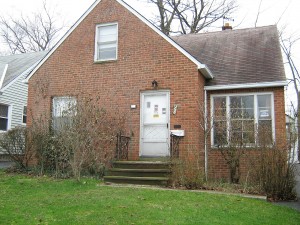
Jean’s house, 2011
Jean was very nice to my mother. When my mom became a widow, Jean didn’t bail on her like some friends of my mom did. And when my mother got Parkinson’s, Jean didn’t bail either. Jean called the building manager at my mother’s apartment because my mom was on the floor and couldn’t get up.
Jean and my mom went way back — to Kinsman Road. They shared a locker in seventh grade. When my mom moved to Cleveland from Mississippi in 1930, Jean welcomed her.
Jean knew me from day one. Jean said I was a fat baby.
I think I have a picture of Jean’s house with the Franklin Roosevelt picture in the den. In the 1940s she bought the picture for her parents, who “worshipped” Roosevelt, she said. “They thought Roosevelt was God. They had always been Socialist before then — voted for Debs — but they took a chance on Roosevelt in 1932.”
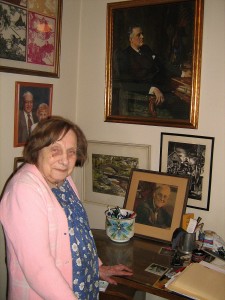
Jean and FDR, 2011
Jean wrote a letter to Eleanor Roosevelt in 1937, asking for help with the Homeowners Loan Corporation, which gave Jean’s dad a loan for a house. Jean had a permanent campaign sign in her front picture window: “Vote Democrat.”
Jean never drove. She took the bus. That was odd, at least for Cleveland. She allowed neighbors to park in her driveway.
Her breakfast was orange juice, hot chocolate and toast. She ate peanut butter and jelly and tea for lunch every day.
That’s some of what you need to know about Jean.
December 19, 2018 5 Comments
A FUNERAL WITH ALL
THE TRIMMINGS
May 15, 1990
Dear Children,
In 15 days I’ll be 71. As you know, I’m not religious, but I do like a good party. About my funeral: Use the gentile funeral home, Fioritto in Lyndhurst, to deliver my body to the Workmen’s Circle Cemetery. Just bury me. Invite some family and friends. No rabbi! I’ve never gone to synagogue, so don’t start with that now.
Pick a convenient Sunday afternoon to throw a memorial service at the Workmen’s Circle hall on Green Road. There is plenty room, a loudspeaker and a kitchen. Anybody who wants to speak, can speak — except Bernstein.
I want a nice sendoff: trays, Scotch, music, dancing, food, coffee, pastry, wine and cold beer. Whiskey too. Hire a klezmer band — Bert Stratton’s band. But remember, one hour of klezmer is enough.
Get the trays at Bernie Shulman’s at Cedar Center. They’re good and cheap, but you have to pick up the goods yourself. Get pastries from Acme supermarket at Mayfield near Green. Their pastries are excellent and much cheaper than the Jewish bakeries.
I want coffee — lots of coffee. The Workmen’s Circle can make it by the gallon. And plenty of soft drinks and wine — good wine. No Champagne. Hire kitchen help.
Mom will say I’m nuts. She can stay home if she wants! This is what I want.
Love,
Dad
—
Footnote: The author — a friend of my parents — died in 2006, 16 years after he wrote this letter. He lived to 87. He had a graveside service with no band and no food. No hard feelings.
I slightly “enhanced” his letter. I added except Bernstein to “Anybody can speak — except Bernstein,” and I added “One hour of klezmer is enough.” Couldn’t help myself. The letter is real.
October 17, 2018 3 Comments
GETTING LOUD
IN THE RESTAURANT
My friend Brian eats out often and is finicky. If his fries aren’t crispy, he sends them back. Brian gets annoyed by cheese. He doesn’t like sharp cheese. If there’s a short pour on the wine, he gets upset.
Brian works the room [the restaurant] like a celeb when he eats out — mostly at places where his buddies are. When we ate at Club Isabella, Brian pointed out the doctors and dentists in the room. Brian said, “That’s the guy who does the dental implants. He runs the full-page ad in the Plain Dealer.”
I said, “When I visit you in California [where Brian lives half the year], you’ve got to do better than docs who do dental implants.” Brian said he would take me to L.A. restaurants where I’ll have a greater than 50-50 chance of spotting celebrities.
Brian likes to say goyim loudly to elicit a reaction from nearby diners. (Nobody reacts. It’s too loud. Nobody hears him.)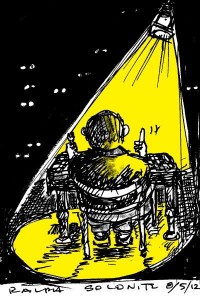
At Club Isabella, I suggested we out on the patio because it was quieter there, but Brian opted for the echo-chamber dining room. That night every happenin’ Jew in Cleveland was at Isabella’s. Brian worked the room: “How was Aspen, Sandy? . . . “How’s your tennis elbow, Jeff?”
I prefer Indian and Chinese restaurants, because they are usually quiet. I don’t like to suck cough drops and sip tea for weeks after nights out with Brian.
—
Brian is a pseudonym.
July 18, 2018 3 Comments
THE SCHVITZ
If you’re a Cleveland Jewish male and have never been to The Schvitz, you are a disgrace. Real Cleveland Jewish men will malign you, impugning your Jewish bona fides. The Schvitz is at East 116th Street and Luke Avenue, off Kinsman Road, in a lousy neighborhood. The Schvitz has no sign. The Schvitz’s official name is the Mt. Pleasant Russian-Turkish Baths, which nobody uses. Some people call it the Bathhouse. Some people call it the Temple of the Holy Steam. (Lawyer Harvey Kugelman does.) Most people call it The Schvitz. It has photos of Mussolini, Dayan and Patton on the walls. That’s it for decorations. (Plus a photo of Clint “Dirty Harry” Eastwood, reports Mike Madorsky.)
There are three acceptable responses to “Have you ever been to The Schvitz?”
a) I held my stag there.
b) I was there with my father.
c) My grandfather took me there.
The Big Five in Russian-Turkish–style schvitzes are in New York, Los Angeles, Detroit, Chicago and Cleveland. I got this list from Billy Buckholtz, the pleytse guy at the Cleveland schvitz. Billy’s grandfather was the original pleytse guy. Pleytse is the rubdown, traditionally done with a broom of soaked oak leaves. Billy uses a seaweed broom and horsehair brush.
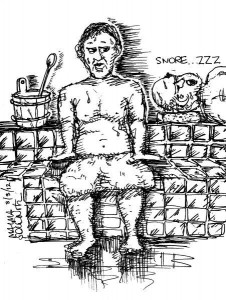
Cleveland’s schvitz isn’t coed. Most of the other schvitzes are. The Detroit schvitz even used to have an orgy night. The Cleveland schvitz never went coed, aside from a short experiment in the 1970s, because the neighborhood is so bad. Why encourage women to come to Kinsman?
In The Schvitz’s heyday, it catered to immigrant factory workers who dropped by after work “to get the creosote off their skin, knock down a few shots and get a pleytse,” Billy said. “The immigrants didn’t want to wait in line with their eight kids for the only bathtub at their house.” Billy told me all this at a Yiddishe Cup gig at an art gallery, not at The Schvitz.
I’m not crazy about steam. I get periodic Schvitz invitations from the Brothers in Perspiration, an ad-hoc group of Cleveland Heights Jews. The email subject-line reads: “Have a serious jones for the stench of sweat, mildew, steak, cigar, garlic?” That sounds good, except for the cigar, sweat, mildew and steam.
—
Rerun
November 1, 2017 3 Comments
RETURN OF THE MAGGIES
Maggies were linoleum salesmen/hustlers in Cleveland. “Maggie” is derived from Magnoleum, a flooring brand. Harvey Pekar wrote a comic strip about maggies in 1982. I didn’t hear the word maggies again until recently, when my cousin Danny Seiger expounded: “The maggies carried thick samples of linoleum that looked like Venetian marble. They sold nine-by-twelve sheets for fifteen dollars. Nobody had fifteen dollars back then, so the maggies took five bucks on installment, and came back with a roll of tissue-paper. They could carry it upstairs real easy. It weighed three pounds. The maggies laid the tissue-paper linoleum on your kitchen floor, collected the five bucks, and never came back.”
The maggies sold more than linoleum, Danny said. They sold ties at barbershops and socks at saloons. Each maggie had a territory and a product line.
I Googled “Maggies” after my cousin Danny left. Maggies, an Irish music group, popped up. Then I tried “Maggies + Pekar” . . .
Michigan State University Libraries,
Comic Art Collection.
“The Maggies: Oral History”/story by Harvey Pekar;
art by R. Crumb. 2 p. in American Splendor, no. 7 (1982).
I phoned Danny Seiger and read the Pekar story to him. I wanted to know if Turk’s deli — where the maggies hung out in Harvey’s comic — was the same place as Seiger’s deli. Danny said, “Turk’s was at One-hundred Seventeenth. We were at One-hundred Eighteenth.”
I said, “There were two delis right next to each other? How many delis were there in Cleveland?”
“There were seven on Kinsman, and twenty-eight in Cleveland in the 1930s,” Danny said.

Seiger’s, 1958, (with fire damage)
–
A version of this first appeared here 8/4/10.
August 30, 2017 3 Comments
THE BILLYS
My parents often name-dropped Billys:
1.) Billy Rose. He put together the Aquacade show at the Great Lakes Exposition in 1936-7. The Aquacade was a theater-like pool. There was an orchestra and synchronized swimming. Johnny Weissmuller starred in it. Billy Rose took the show to the New York World’s Fair in 1939.
2.) Billy DeWolfe, a character actor. Billy De Wolfe occasionally ate at Seiger’s, my Great Uncle Itchy’s restaurant on Kinsman Road.
3.) Billy Weinberger, a Short Vincent Street restaurateur. He owned Kornman’s. Billy Weinberger moved to Las Vegas in 1966 and took over Caesar’s Palace. Billy was close with the Cleveland mobsters who started Vegas. My Uncle Al — not a gangster — once got discount hotel rates from Billy in Vegas.
I never name-dropped Billys to my kids. My parents took all the Billys.
—
A version of this post appeared here 10/19/11.
—
Funk a Deli (formerly known as Yiddishe Cup) plays at John Carroll U. 7 p.m tomorrow (Thurs., Aug. 10). On the lawn. Free ice cream. Featured guest artists: Shawn Fink, Jack Stratton, Rick Lawrence, Maury Epstein and David Krauss.
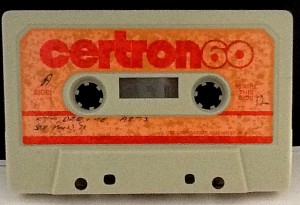
August 9, 2017 6 Comments
A LOVE SUPREME
The Jazz Temple was a former Packard showroom at Mayfield Road and Euclid Avenue. Coltrane and Dinah Washington  played there. The Jazz Temple was in business from 1960 to 1963. I passed the Jazz Temple weekly on my way to Sunday school at The Temple, the gold-domed Reform temple in University Circle.
played there. The Jazz Temple was in business from 1960 to 1963. I passed the Jazz Temple weekly on my way to Sunday school at The Temple, the gold-domed Reform temple in University Circle.
Rabbi Abba Hillel Silver was the head rabbi at The Temple. He once spoke at the United Nations, advocating for the founding of the State of Israel. Rabbi Silver’s son, Dan, was the assistant rabbi. Dan played football at Harvard and occasionally wrote for the Cleveland Edition.
At Sunday school, kids were mostly from Shaker Heights. One kid got a ride in a limo to temple. The driver wore a chauffeur’s cap. The limo wasn’t a Rolls; it was a Buick station wagon.
I couldn’t grasp how temple — the word — fit into the Jazz Temple. Was Jazz a religion too? Many years later, I met former beatniks who had actually gone to shows at the Jazz Temple.
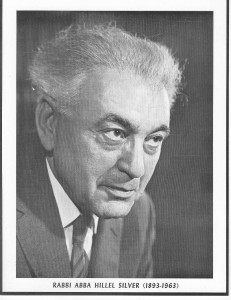 The Jazz Temple was blown up in 1963. Somebody didn’t like the club or the owner, Winston Willis, a controversial black businessman. At The Temple religious school, we students attended services every Sunday morning to hear Rabbi Silver. (Services were on Sunday, not Saturday, in the 1950s at Silver’s.) Rabbi Silver looked like God. Nowadays, at The Temple East in Beachwood, there is a Abba Hillel Silver memorial study. The rabbi’s desk is laid out like he just stepped out for lunch. He died in 1963, just six days after Kennedy got murdered.
The Jazz Temple was blown up in 1963. Somebody didn’t like the club or the owner, Winston Willis, a controversial black businessman. At The Temple religious school, we students attended services every Sunday morning to hear Rabbi Silver. (Services were on Sunday, not Saturday, in the 1950s at Silver’s.) Rabbi Silver looked like God. Nowadays, at The Temple East in Beachwood, there is a Abba Hillel Silver memorial study. The rabbi’s desk is laid out like he just stepped out for lunch. He died in 1963, just six days after Kennedy got murdered.
—
A slightly different version of this appeared 9/5/12. If you need baseball stuff, see my story at City Journal.
November 2, 2016 5 Comments
NO HARD FEELINGS,
SAYS COUNCILMAN POLENSEK
Nobody out-talks Cleveland Councilman Mike Polensek. He’s the quote machine. He once said, “I’m old-school Collinwood. You mess with me or my property, and I mess with you.” He called former councilman Jay Westbook a “weasel,” and former mayor Mike White a “son of a bitch, but our son of a bitch.”
Before Polensek was a councilman, he was a machinist at White Motors. I saw Polensek frequently in 1981 and 1982, when I was a reporter for the Sun Scoop Journal. Polensek ran for city council against Dave Trenton — a fellow incumbent Slovenian — in 1981. The city wards had been redrawn, and Polensek or Trenton was going to be out of a job. Trenton was “shanty Slovenian,” said my editor, another Slovenian. Trenton was slightly rougher-edged than Polensek. For instance, Trenton smoked a cigar in public.
 The editor endorsed Trenton, maybe because he and Trenton played softball together. The editor told me to survey the 14,000 registered voters in the ward. I talked to 75 people. Trenton received 32 votes in my poll. He had a plurality. The paper ran this headline: “Trenton called favorite in Ward 11 race.” And the endorsement stated: “As council’s majority leader, Trenton can serve the community from a position of strength . . . [He has] invaluable connections downtown.”
The editor endorsed Trenton, maybe because he and Trenton played softball together. The editor told me to survey the 14,000 registered voters in the ward. I talked to 75 people. Trenton received 32 votes in my poll. He had a plurality. The paper ran this headline: “Trenton called favorite in Ward 11 race.” And the endorsement stated: “As council’s majority leader, Trenton can serve the community from a position of strength . . . [He has] invaluable connections downtown.”
But Polensek, the underdog, won! When I walked into Polensek’s victory party at the Italian Cooperative Association Hall on St. Clair Avenue, a Polensek supporter announced, “Your paper endorsed Trenton!” Another man said, “You’re in the wrong place. You’re going to eat crow when you write up your shit. You’re one of the worst writers ever! What are you doing here?” A woman, somewhat calmer than the men, said, “I don’t think you’re going to find what you’re looking for here.”
They didn’t like me. (I was a curly-haired hippie Jew from the Heights. That didn’t help.) But Polensek liked me — liked me enough. He liked media people, period. He said, “Oh well, you’re here. Like I told your boss, I knew we’d win.” I said I would have voted for Polensek if I lived in Ward 11. Polensek wasn’t impressed. He said, “You’re disrespecting your boss.”
Polensek is still a councilman 35 years later. I ran into him a couple years ago and said, “You remember the ICA Hall, when some of your supporters wanted to kill me?”
He was foggy on it. I wasn’t. He said, “No hard feelings.”
February 24, 2016 5 Comments
HALF A JEWISH TOUR
 Exploring Jewish Cleveland
Exploring Jewish Cleveland
1850 – 1950
Tuesday, September 20 • 9:30 – 3:30
$30 JCC Members; $40 Non-members
Registration deadline: September 15
Code: 6316
Meet by the Mandel JCC front entrance
I bailed from the tour halfway through (at Liberty Hill Baptist Church, formerly Euclid Avenue Temple). I was on the bus for four hours, and the tour had three more hours to go, according to the guide. I can do local Jewish history but not seven hours. I missed Kinsman and Glenville. I caught the Central neighborhood portion. James A. Garfield (not Jewish) and Mickey Katz graduated from Central High.
I’d like two half-day tours of Jewish Cleveland.
—
Here’s “Homeboy,” about growing up in Cleveland and never leaving. From City Journal. L’shana tova.
September 9, 2015 1 Comment
CARMA
My son Ted parked his car at the Brookpark RTA lot and flew to Las Vegas. The RTA lot was cheaper than the airport lot. My son didn’t come back. I thought he was going on a vacation, but he got a job in Las Vegas and stayed for a while.
My son’s Ford Focus, a 2007, sat in the Brookpark lot for two months, until my wife, Alice, and I loaded our car with jumper cables and a generator air pump and drove to the RTA lot, which is next to Ford Engine Plant #1 and a couple strip bars.
I said to Alice, “Ted’s car is technically in Brook Park, not Cleveland. That’s good. If the car has been towed or stolen, we can deal with Brook Park red tape better than Cleveland red tape.”
But the car wasn’t towed or stolen. It was there. The doors were unlocked, and the tires were low, and there was a bottle of bourbon in the backseat.
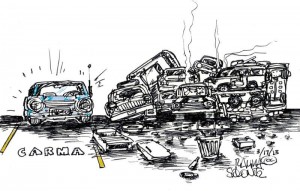
The next day I drove Ted’s car to the Lusty Wrench in Cleveland Heights. Sam Bell, the repair-shop owner, said, “The car is basically in good shape, with 89,000 miles. The battery will not make it, and as you know the side-view mirror is taped on. But the tape actually is not a bad solution. The rear tires are round, black and hold air.” The car was serviceable, he proclaimed.
What I want to know, Is Greater Cleveland really this safe? I need more data. Please park your car for two months at a Rapid stop and tell me.
—
This post first appeared at CoolCleveland.com 5/15/13.
—–
SIDE B
Here’s something new . . .
RECALCULATING
You dislike yourself for several very good reasons:
- You fist-bump too much. That is so childish. Shake hands!
- You have tiny cracks in your fingers that irritate others. Try fist-bumping.
- You are not 25, so act your age.
- Your sexuality is questionable.
- Cut back on the Facebook postings. Three a day is
too many. - Don’t be so jittery.
- Move to a log cabin. Or else go to an airport lounge with your laptop and iPhone, and live there for a week.
- Doodle more.
- Recalculating . . . ignore this.
May 13, 2015 3 Comments






